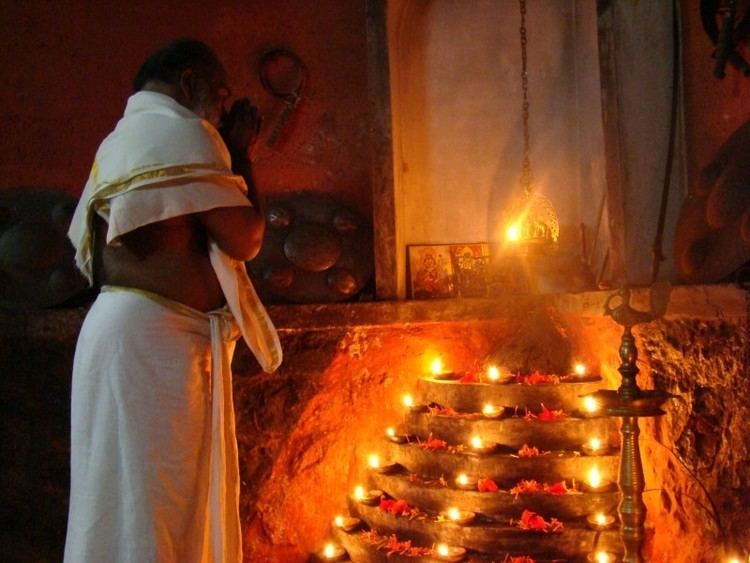 | ||
The word Kalari means "threshing floor" or "battlefield" in Malayalam and Tamil. Training for Kalaripayattu, a martial art of Kerala is traditionally done inside the Kalari. Also the past village schools of Kerala, run by the traditional astrologers families were known by the name Kalari or Ezhuthu Kalari.
Contents
Every Kalari has a Puttara (meaning "platform where flowers are kept" in Malayalam). The Puttara is a seven tiered platform placed in the south-west corner and houses the guardian deity of the Kalari. The seven tiers symbolise the seven sisters of Amritavani whom where Chekavars of North Malabar were born. These 7+1 system is the basis of 7+1 illams of Thiyyas (Chekavar) of North Malabar. Other deities, most of them incarnations of the Bhagavathi or Shiva, are installed in the corners. Flowers, incense and water are offered to the deity every day.
Kalari teachers
The teacher in Kalari is called Guru or Asan. Teachers of Ezhuthu Kalari or Ezhuthu Palli too were known as Asan or Ezhuthassan.The traditional astrologer caste Ganaka or Kaniyar were the Preceptors of fencing techniques They are still addressed by the title Panickar in certain regions of Kerala. It is believed that the duty of training martial arts was assigned to this sect by Parashurama in Keralolpathy.
Construction of a Kalari
Traditionally the Kalari is constructed by digging a hollow in the ground forming a sunken area four feet in depth, forty-two feet in length and twenty-one feet in breadth. This is usually called KuzhiKalari. Kuzhi means "portions formed by caving in the earth" in Malayalam.
The entrance to the Kalari is in the east, to let in the morning sunlight, and leads into the forty-two foot leg running East-West while the twenty-one foot leg runs North-South. Another consideration taken when constructing the kalari is that it is built in the south-west side of the main plot, just like the puttara which is kept in the South-West corner of the Kalari itself. The floor of the Kalari is leveled using mud.
In the southern and central kerala some kalaries were constructed in circular form and weapons and other instruments were placed on one end and outside the circular are the students used to sit and watch the training.
AnkaKalari and Ankathattu
Ankathattu is a four to six feet high platform constructed temporarily for the purpose of fighting duels. Ankam means war in Malayalam. This platform is constructed as per tradition and is in the center of the ground from where people can watch the fight. The entire arrangement is called Anka Kalari.
Historically, in Kerala, quarrels between local rulers were resolved by fixing an Ankam, a duel to the death, between two Ankachekavars, each ruler being represented by one Ankachekavar. The ruler represented by the surviving Ankachekavar was considered the winner.
Kalari in literary works
Information about Kalari is found in the Tamil literary work Purananuru. The word "kalari" appears in the Puram (verses 225, 237, 245, 356) and Akam (verses 34, 231, 293) to describe to both a battlefield and combat arena. It speaks of the Kalari talents of Tamil kings of the Chera, Chola & Pandya dynasties and Pallavas.
